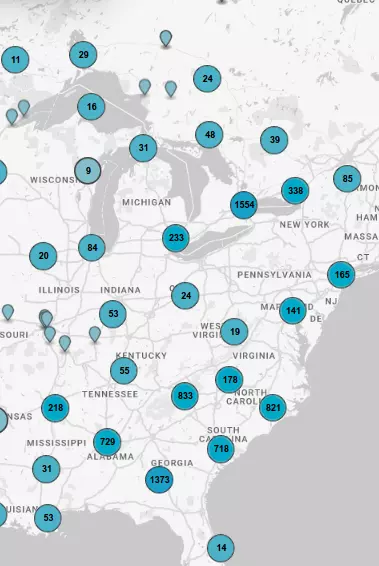Hero's Memorial
North of this marker in the Porterdale Cemetery is the grave of Bragg Smith over which the City of Columbus erected a marble memorial to commemorate an outstanding deed of heroism. The text...
- lat34
Wildwood
Augusta Jane Evans Wilson, author of St. Elmo and other popular Victorian novels, was born May 8, 1835, in "Wildwood" the early Georgian home northeast of this marker. She was the daughter...
- lat34
Springer Opera House
Theater in Columbus found its finest home on February 27, 1871, when Francis Joseph Springer, Originally from Alsace, opened his opera house. The Springer´s forty foot deep stage held a continuous...
- lat34
City of Columbus
This city of Columbus was created as a trading town by an act of the General Assembly of Georgia, December 24, 1827. The location designated was on the Chattahoochee River near the Coweta...
- lat34
Confederate Hospitals
In February 1864, to relieve the serious overcrowding of Confederate hospitals in the Atlanta and Dalton areas, Columbus was chosen as the site of a 1500 bed army hospital. Eight buildings on...
- lat34
Confederate Dead
More than 200 soldiers from every Confederate state are buried in two separate plots in Linwood Cemetery. Many of these men died in the several Confederate hospitals located in...
- lat34
Col. W. L. Salisbury
This park is named for Col. W. L. Salisbury (1830-1878), soldier, editor, banker, distinguished citizen of Columbus whose contribution to progress and culture in his native city was outstanding....
- lat34
He Helped Bring and Keep Fort Benning
Mallory Reynolds Flournoy (Oct. 21, 1882- Apr. 26, 1920) leader in establishing Fort Benning and the Infantry School on the 182,000 acre military reservation south of Columbus lived here. The...
- lat34
City Mills
Site of the oldest manufacturing operation on the Chattahoochee River at Columbus, April 3, 1828, the State of Georgia through Governor George R. Gilmer, issued a grant to Seaborn Jones for...
- lat34
Red Jacket
Red Jacket, a small brass cannon, was first used in firing a salute of 500 guns when Georgia seceded from the Union. In custody of the Columbus Guards, it fired salutes at the inauguration...
- lat34
Textile and Banking Pioneer
Site of the home of William H. Young (1807- 1894), a native of the State of New York who migrated to Georgia at the age of 17. Visiting the site of Columbus a year before the city was...
- lat34
Ladies Defender
A muzzle loading cannon cast in Columbus in 1861 from brass contributed by the ladies of the city from their domestic furnishings and utensils. Used about a year in the Confederate Artillery, it...
- lat34
Torch Hill
On the summit of the rise to the east is the site of "Torch Hill", home of Dr. Francis Orray Ticknor (1822-1874), author of the famed war story, "Little Giffen of Tennessee". Dr. Ticknor was...
- lat34
Eagle & Phenix Mills
In 1851 the Eagle Mill, one of the pioneer textile plants of Columbus was built on this site to manufacture cotton and woolen goods. During the war the mill manufactured goods for the Confederacy...
- lat34
Haiman's Sword Factory
Site of Haiman´s Sword Factory, the largest plant of its type in the South during the War Between the States, Louis and Elias Haiman came to Columbus from Prussia in the 1830s and established a...
- lat34
Camp Conrad
Main entrance to Camp Conrad, where a brigade of 3,500 troops was stationed in the winter of 1898-1899 (Spanish-American War). Camp sire occupied space between Third and Sixth Avenues and 29th and...
- lat34
The Columbus Guards
Site, of the last armory of the Columbus Guards, a noted military company charted by the Georgia Legislature in 1843 and organized in 1835. They served voluntarily in the Indian War 1836; the...
- lat34
Confederate Memorial Day
The first Confederate Memorial Day service in Columbus was held on this site (St. Luke Methodist Church) on April 26, 1866. The program was under the auspices of the ladies´ Memorial...
- lat34
Columbus Iron Works
Established 1853, was operated by the Confederate government as Naval Iron Works making cannon, other war munitions, and two gun boats. This plant was credited with making the first breach...
- lat34
Blind Tom
200 feet east is the grave of Thomas Wiggins, (1843-1908). As "Blind Tom" he thrilled audiences here and in Europe with his remarkable musical performances. Born a slave, his native genius...
- lat34
